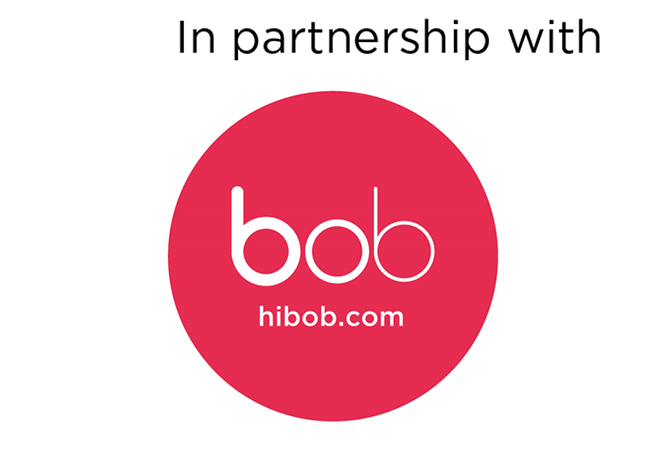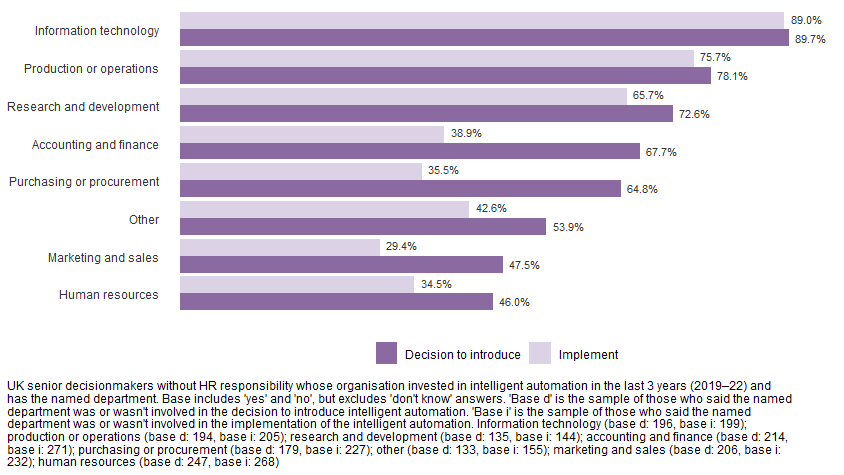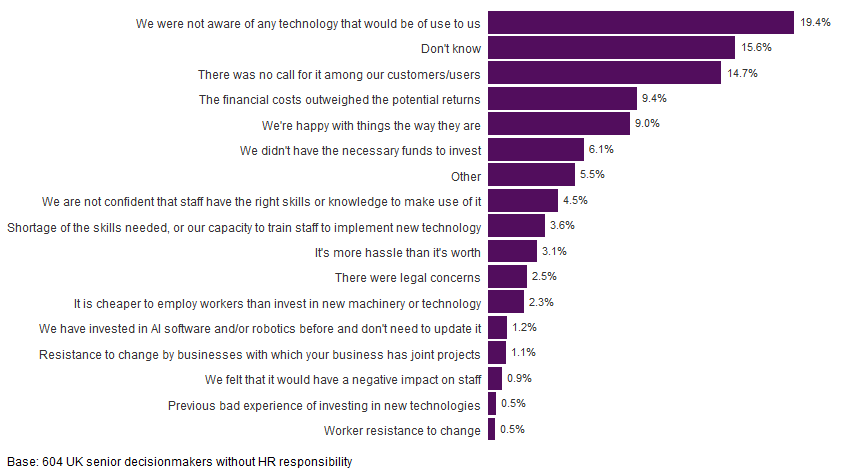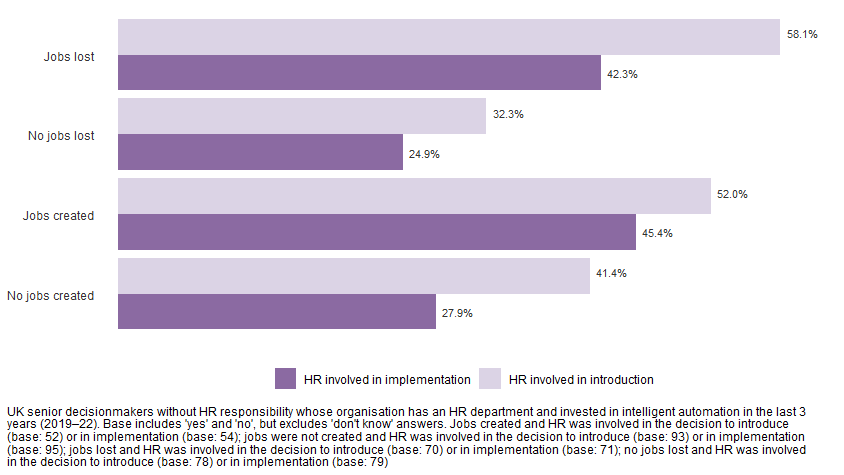Bringing on the brain bots – a missed opportunity for HR?
Should HR be more involved in introducing or implementing intelligent automation?
Should HR be more involved in introducing or implementing intelligent automation?
 |
‘Intelligent automation’ is the automation of business processes using artificial intelligence (AI) and related technologies. It’s also known as intelligent process automation or hyperautomation. It has the potential to eliminate tasks for people and create new ones (good and bad), and there have been many attempts to quantify its impact on jobs. |
But how is intelligent automation being introduced and implemented in the first place? Given its impact on jobs and people, how involved is HR in the decisions and processes around it? To answer these and other questions, the CIPD asked UK bosses the main reasons for investing or not investing in intelligent automation and the extent to which HR and other departments were involved in decisions to invest or implement it. We also asked whether intelligent automation has increased or decreased the number of jobs in their organisations. We reused some of the questions on AI and automation from our 2018 survey which was covered in the People and machines: from hype to reality report.
This time, however, we intentionally excluded bosses with HR responsibility and referred to intelligent automation rather than AI and automation. We also asked for key examples of intelligent automation that their organisations have invested in over the last three years (2019–22) to provide more context.
As with our 2018 survey findings, HR is still among the departments that are less involved in decisions to introduce intelligent automation or in its implementation (Figure 1).
Figure 1: Departments involved in the decision to introduce or in implementing intelligent automation

Looking at Figure 1, it is perhaps no surprise to see IT’s high involvement. But it is interesting to see from our sample that production or operations departments are more likely to have spent resources on intelligent automation than others. With accounting and finance departments having oversight of budgets, it makes sense that they’re more involved in decisions to introduce than in the implementation.
If the technology is not expected to significantly change the number of workers or how they work, then it might follow that HR is less likely to be involved in the decision to introduce as can be observed in the graph. But HR’s relatively low involvement in implementation – which would probably require staff engagement and participation – may be a real missed opportunity. But before exploring this further, let’s backtrack and explore what else bosses said about intelligent automation.
Of the 814 bosses we surveyed, only 29% said their organisations had introduced intelligent automation in the last three years (Figure 2). They were mostly from private sector services and large organisations with over 250 employees worldwide.
Figure 2: Has your organisation introduced intelligent automation over the past three years (2019–22)? This can be across the organisation or within certain departments

Just over half of respondents (53%) said their organisation did not introduce any intelligent automation between 2019 and 2022. The most cited reason was that they weren’t aware of any intelligent automation technologies that would be of use in their organisation (19.4%). The next most common reason was that customers or users did not ask for it (14.7%). A significant percentage of bosses didn’t know why no investments were made (15.6%). Interestingly, worker resistance to change and previous bad experiences were not among the main reasons for avoiding investment in intelligent automation (Figure 3).
Figure 3: Main reasons for not introducing intelligent automation

Among those who did introduce intelligent automation (Figure 4), reducing overall costs (26.3%) was by far the most cited main reason for its introduction. This was followed by improving the quality of goods and services (16.6%). In the 2018 survey, the order was reversed, with cost reduction second to quality improvement, though there was little difference between them (11.4% and 16.1% respectively). The added focus on reducing overall costs this time may have been fuelled by costly external disruptions such as the pandemic, the war in Ukraine and Brexit. This increased motivation could present opportunities for organisations that produce or implement intelligent automation solutions for other organisations.
Figure 4: Main motivation for introducing intelligent automation

It’s hard to say whether HR should’ve been involved simply by looking at the examples. For instance, there were job gains and losses in the case of introducing engineering calculations in business services, yet HR was not involved in the decision to introduce or in implementation. We don’t know how significant the job gains and losses were, and whether all displaced people were assigned to new roles in the organisation. The responsibility for discussing reskilling may have been delegated to line managers.
Some respondents shared their opinions on the adopted technology, both positive and negative. One senior manager in the construction industry offered a positive view:
“Increasing use of AI technology in automation of components for design organisations. No loss of employees, they get to spend more time on more enjoyable tasks that AI could not replicate.”
Others reported a negative experience like this non-executive director in the public sector (HR was the client here):
“Introduced an AI system into the HR function to replace staffing. It was a disaster. The system could not get processes correct. Created many issues and was withdrawn at significant cost.”
Some, like this senior IT manager in the healthcare industry, saw both benefits and drawbacks for their organisation and people:
“Assessment of invoices and expenses now handled by RPA bots, along with data entry. Impact is higher accuracy and loss of jobs, resulting in reduced cost of operation. However, when issues arise it is now more difficult to resolve as the people with intimate knowledge of the processes and data are no longer there to resolve.”
In the first case, HR was only involved in the decision to introduce intelligent automation. In the second two cases, HR was also involved in the implementation of the automation. Overall, what we can learn from the three cases is that being involved is not enough – the quality of involvement matters too.
Technology can create new tasks and jobs for people or do away with existing ones. More bosses said that the intelligent automation introduced resulted in job losses (43.3%) than those who said jobs had been created (34.7%) (see Figure 5). It was the other way round in the previous survey – 40% said AI and automation led to job losses while 43% said it led to new jobs being created.
Figure 5: Whether the introduction of intelligent automation resulted in jobs being created and/or lost

Digging deeper, we can see that HR was more likely involved in decisions to introduce or in the implementation of intelligent automation where new jobs were created than where no jobs were created. Similarly, HR is more likely involved where there were job losses than where there were no job losses. These findings are consistent with those from the previous survey.
Figure 6: HR involvement in the decision to introduce or in implementing intelligent automation is more likely where jobs are created or lost

A point to note is that these figures only tell us if jobs were created or lost in the respondents’ organisations, not whether the total number of jobs went up or down. In any case, the fact that intelligent automation often leads to fluctuations in jobs should of itself be a prompt for HR involvement in the process. And of course, apart from the focus on the number of jobs, the quality of jobs that are being created should not be forgotten. Again, this is a clear opportunity for HR involvement.
There are opportunities for HR to be involved where the intelligent automation (or other workplace technology) is expected to significantly impact people. How can people be supported to prepare for future jobs in the organisation or elsewhere? How can we ensure that the new jobs are good jobs? At a strategic level, there are opportunities to link plans for intelligent automation with workforce planning and reviews of the organisation’s structure and culture. There’s so much more than just recruiting and dismissing people.
In practice, this of course depends on HR’s existing remit, capacity, whether HR wants to get involved, and importantly, if it can add value. While we know from our previous research that large digital transformations tend to be led by other departments, we also uncovered examples of HR professionals who expanded their roles and added value in the process.
If you’re involved in discussions to invest in technology (or would like to prepare for one), do take a look at Table 2 (p11) of CIPD’s Responsible investment in technology guide for ideas on what to ask. Because when we invest in technology, it is vital to consider the impact on people as well as the organisation.
See our partner Hibob’s articles on AI and automation:
The next article in this series will examine the responsible use of AI.
Browse our A–Z catalogue of information, guidance and resources covering all aspects of people practice.
Discover our practice guidance and recommendations to tackle bullying and harassment in the workplace.

Hayfa joined us in 2020. Hayfa has degrees in computer science and human resources from University of York and University of Warwick respectively.
She started her career in the private sector working in IT and then HR and has been writing for the HR community since 2012. Previously she worked for another membership organisation (UCEA) where she expanded the range of pay and workforce benchmarking data available to the higher education HR community.
She is interested in how the people profession can contribute to good work through technology and has written several publications on our behalf, as well as judging our people management awards, speaking at conferences and exhibitions and providing commentary to the media on the subjects of people and technology.

An overview of the purpose and benefits of HR policies and how to implement and communicate them effectively throughout an organisation

Listen to episodes from our CIPD Ireland Podcast Series on a range of topical workplace, HR and L&D issues
Listen now
Listen to our new fortnightly podcast providing expert insights from HR leaders on the topical issues impacting the world of work
Listen now
Our series on current practices, future models and successful transformations

We look at the main focus areas and share practical examples from organisations who are optimising their HR operating model

Our series on current practices, future models and successful transformations

We look at what’s driving change in HR structures, what emerging models look like and what to consider when evolving your current model

How can L&D teams can engage with new technologies like generative AI to impact performance?